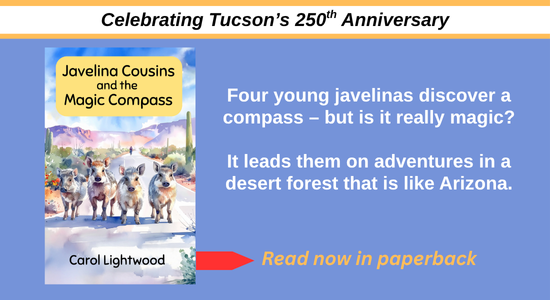Today’s forecast in Tucson is for a high temperature of 111 degrees Fahrenheit. Too hot to do more than water the plants in pots and sweep up leaves from yesterday’s winds. It’s like this almost everywhere in the Southwest. Even southeastern California is scorching. (The exceptions are the sky islands of Arizona and Nevada. More about them later.)
So what’s a gardener to do? For me the solution is clear: visit the shadiest public garden nearby preferably in the morning and preferably with a gardening friend.
Seeing the wide range of heat-tolerant plants thriving in the public garden is the summertime equivalent of perusing seed catalogs in winter. You and your friend can look. You can even take notes if you see something very special. But you cannot really do anything about planting in your hot, dry garden until the weather cools months from now. Then after the plant-viewing is done, stop at the cafe in the public garden for a light lunch in the shade. Perfect!
Escape to a public garden
So, here are a few public gardens I’ve visited during the sizzling hot summer months over the past 20+ years I’ve been writing Hot Gardens. Often, I confess, my goal in recent years is to go for a shady walk in an appealing urban space and have a fun lunch with friends. Plants are just an extra.
(For a list of all the gardens I’ve written about on Hot Gardens, go here.)
I’ll start with the obvious: Tucson Botanical Gardens. It was founded in 1964 in the back yard of a horticulturist, Harrison Yocum, so the trees in parts of this garden are 60 years old and the walk ways are shady. Two new additions to this garden are an expanded cactus and succulent garden and a whimsical installation of model trains and model historic buildings in what was once an ignored corner of the garden. Both USA Today and TripAdvisor recommend this public garden. I do, too.
The San Antonio Botanical Garden is 38 acres of surprises. Rather than focus on drought-tolerant plants, the goal of this public garden is to showcase the wide variety of plants and eco-systems in Texas. Among the things you will see is the dramatic Lucile Halsell Conservatory complex with its towering glass buildings. There are also old residences surrounded by historic plantings. And contemporary displays of plants. And a bird-watching station. And a culinary garden. And…, well, it’s Texas so there is more, much more.
Plan your visit to the Phoenix Botanical Gardens at night! From June through September there are ‘Flashlight Nights’ that let you see the gardens after sundown. Each of these nights has special events and snacks for desserts, too. The exhibitions of plants and the indigenous people of the Southwest are favorites of mine. The trails through the Gardens aren’t consistently shady so nighttime visits are best. Check the website for dates and times.
When I lived in Los Angeles, my go-to public garden was not the large L.A. Arboretum, but the much smaller and shadier Descanso Gardens, tucked back in the hills above Glendale. Originally it was a commercial garden with camellias and roses grown for sale. Now camellias and roses make up only two parts of Descanso Gardens. There is also a Japanese Garden with a tea house, a lilac garden with blooms in Spring, a small drought-tolerant garden, an Oak woodland with soft-underfoot trails, a little train for children to ride, and an art exhibition near the original home on the property plus a cafe for lunch under the pergolas near the entrance. (And the glorious poppy, below, is just for a beauty of it.)
Historically, plants have not always been the primary focus of gardens. The ancient gardens of the Roman, Persian and Chinese empires always placed the enclosing architecture, the water features and the buildings as the most important elements of that protected, outdoor space we call a garden. Plants were more like ornaments in those gardens. The Getty Villa in Malibu and the Chinese Garden at the Huntington Gardens are both examples of the ‘architecture-first’ gardens. And both these gardens are also noted for their art collections. So if you go to California this summer, visit either or both of these for a more-than-gardens experience. I recommend lunch at the Getty Villa overlooking the Roman garden, below, and Pacific Ocean. The food is good; the view is better. And it’s always cool!

Now about Sky Islands
Sky Island is the common designation for locations over 5,000 feet in elevation in mountains that rise up steeply out of hot deserts. Up there it’s cool — 20 to 30 degrees cooler than the land down at the foot of the mountains. Both Mt. Lemmon near Tucson and Mt. Charleston near Las Vegas are sky islands. Hiking and camping are comfortable experiences during summer months when you are that high up. And you can simply ignore your garden for a while. Stay cool!
Read our 8 most popular newsletters
- Best and beautiful native shrubs for extreme heat
- Five fragrant plants for your garden
- Where to get free or cheap trees for your garden
- Six distinctively different landscapes to replace a lawn
- Cover up that naked wall
- Nine trees to combat climate change
- Four desert trees good for soil, 4 toxic ones
- Plants that bloom even in mid-summer scorching heat
Visit my author’s site to see books I’ve published.
Related
Discover more from
Subscribe to get the latest posts sent to your email.
